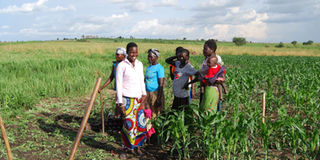Gains in agricultural sector yet to be felt despite increased budget allocation

Gains in agricultural sector yet to be felt despite increased budget allocation
What you need to know:
- According to the 2018/19 budget speech, agricultural sector growth has been low, growing at an average annual growth rate of less than 2 per cent over the last 25 years, compared to population growth of 3 per cent annually;
- Small and Medium Enterprises (SMEs), Manufacturing Firms and other Private Sector entrepreneurs are still faced with high costs of electricity and transport, limited and expensive financing and competition, mainly from cheaper goods from Asia.
- There is also inadequate or inappropriate skilled labour failing to meet the manpower requirements for the job market;
- Low entrepreneurial knowledge and limited application of technologies in production processes, particularly in agriculture and industry.
Agriculture is one of the sectors of the economy that has in recent years seen some increases in its budget allocation.
But, the question being asked by some stakeholders among them the Civil Society Organisations and a section of policy and budget analysts is: where is the value for money?
In the budget speech read by the Minister of Finance, Mr Matia Kasaija last week, the government allocated Shs893billion to agriculture, an increase of nearly 65billion compared to the previous allocation.
And this has been the case over the last three financial years, no matter how nominal the increases are.
Despite the increases in funding over the years, it was evident in the budget speech delivered by Mr Kasaija that about 68.9 per cent of Ugandan Households remain engaged in the subsistence economy.
“These households are highly vulnerable to risks such as drought that results from climate change. 43 per cent of these households are engaged in subsistence agriculture, producing what they consume,” Mr Kasaija said.
He continued: “Whereas income per person has increased, inequality between rural and urban areas has risen with rural poverty rising from 22.8 per cent in 2013 to 25.8 per cent in 2017, against a marginal increase in urban poverty from 9.3 per cent to 9.4 per cent over the same period.”
Baffling state of affairs
It is partly against this background that CSOs such as PELUM and Uganda Debt Network as well as section of policy and budget analyst gets concerned with the state of affairs in the sector that provide the livelihood to the majority of the population, let alone being the biggest earner of the export revenues.
“In the last three financial years, there has been an increment to the budget allocation to the sector (agriculture) in terms of volumes of money but the critical needs of the farmers are not adequately addressed,” Ms Josephine Akia Luyimbazi, PELUM programmes manager said in a statement.
She continued: “Areas such as extension services, water for production, pest and diseases, agriculture insurance are not being adequately addressed despite increases in volumes of money in the sector.”
In response to the sector allocations, Uganda Debt Network director of programmes, Mr Julius Kapwepwe Mishambi wondered what kind of commercial agriculture the country is pursuing in the first place.
He told the participants whom together with PELUM they hosted during the reading of the 2018/19 budget in Kampala that the nature of commercial agriculture being pursued lacks clarity, considering that most farmers in the country are small holders.
He noted that most small holders’ farmers have not even benefitted from the financing arrangement that the government tends to front.
In his submission, Dr Fred Muhumuza, a policy and budget analyst: said: “The devils are always in the details. Most of the allocations goes in paying of salaries and some that are used in the provision of seedlings, you must interrogate what kind of seedlings are they, including the quality being provided.”




